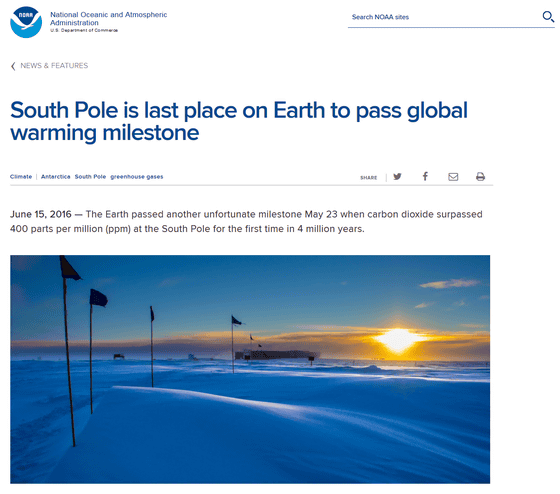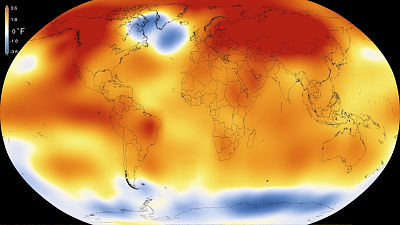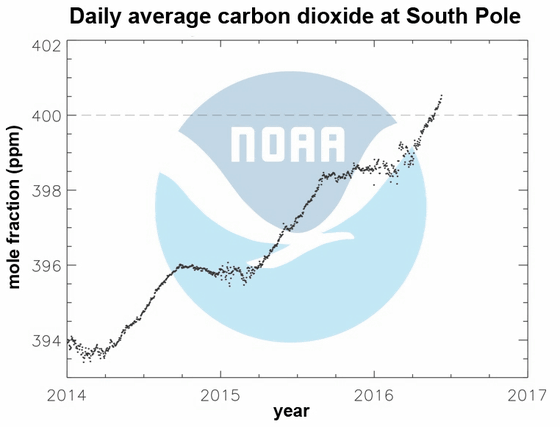Carbon dioxide concentration reached 400 ppm in Antarctica for the first time in 4 million years, the highest concentration in observation history

ByChristopher Michel
The US Oceanic and Atmospheric Administration (NOAA)Announced that the concentration of carbon dioxide (CO 2) in Antarctica exceeded 400 ppm on May 23, 2016. Although it has already recorded over 400 ppm at various stations at the observation point on the ground, over 400 pm in Antarctica is considered to be the first time in NOAA's observation history, the first time in 4 million years.
South Pole is last place on Earth to pass global warming milestone | National Oceanic and Atmospheric Administration
http://www.noaa.gov/south-pole-last-place-on-earth-to-pass-global-warming-milestone

Antarctic CO2 Hit 400 PPM For First Time in 4 Million Years | Climate Central
http://www.climatecentral.org/news/antarctica-co2-400-ppm-million-years-20451
NOAA began observing CO 2 concentration from 1958. As for the tendency, it increases from late autumn to spring in the Northern Hemisphere, and then decreases towards the summer from there. This is because the land is plentiful in the Northern Hemisphere, plants photosynthesize and consume CO2, so it is obvious when you see a movie of the annual CO2 concentration trend published by NASA.
A masterpiece movie visualizing the flow of carbon dioxide on a global scale - GIGAZINE

The data is for 2006.
"Global warming" has been a problem for the last 30 years, and efforts to reduce emissions are being implemented globally for "greenhouse gas" which is the main cause, but as one of the greenhouse gases, CO2 emissions Rarely decreases, rather it increased by 2 ppm for 4 consecutive years since 2012. In 2015, the increase in CO2 at the Mauna Loa Observatory in Hawaii is the largest value in the past 56 years3.05 ppmWas recorded.
Atmospheric CO2 in the world, one year skyward photographs by 2015 International News: AFPBB News
http://www.afpbb.com/articles/-/3080017
The biggest increase in 2015 is due to forest fires, drought, heat waves, etc., which are caused by the El Niño phenomenon, which is caused by unseasonable weather. As a result, the concentration of CO2 in the atmosphere isWorld average 402.59 ppmReached.
It is confirmed that it was "the warmest year" in 2015, greatly updated the record of 2014 - GIGAZINE

Even in such an environment, it was Antarctica that kept less than 400 ppm. This is due to the fact that the amount of CO2 emissions inevitably increases because of the large number of human activities, which is also a particularly distant place from the Northern Hemisphere, and Peter Tans, the lead scientist of NOAA's World Greenhouse Gas Reference Network He also said that "Antarctica was the last place on the ground that did not record CO2 concentration 400 ppm", that is, it was also "the last fortress of global warming".
However, the increase in CO2 emissions has not declined in 2016, and on 23 May 2016 it was decided to record more than 400 ppm at the Antarctic. Graph of the CO2 concentration transition in Antarctica after 2014 is like this. It can be seen that over 400 ppm was unavoidable.

By NOAA
According to NOAA, the record of "the annual increment of CO2 concentration over 2 ppm" continues for 20 years and it is certain that it will be for 5 consecutive years, and it is expressed as "unfavorable milestone arrival".
Research teams at the Hadley Center and the Exeter University in the United Kingdom Meteorological Administration Hadley Center and the Exeter College use CO 2 emission data, seawater temperature data and climate models, the CO 2 concentration observed at the Mauna Loa Observatory in 2016 will not exceed 400 ppm, Including the increase width ofIn the future, at Mauna Loa Observatory, no more than 400 ppm will be observedThe conclusion is put out.
El Nino and a record CO2 rise: Nature Climate Change: Nature Publishing Group
http://www.nature.com/nclimate/journal/vaop/ncurrent/full/nclimate3063.html
By the way, according to NOAA, it reached this standard for the first time in 4 million years. That is,AustralopithecusIt will have been since the time when it would have survived.
Related Posts:
in Science, Posted by logc_nt







